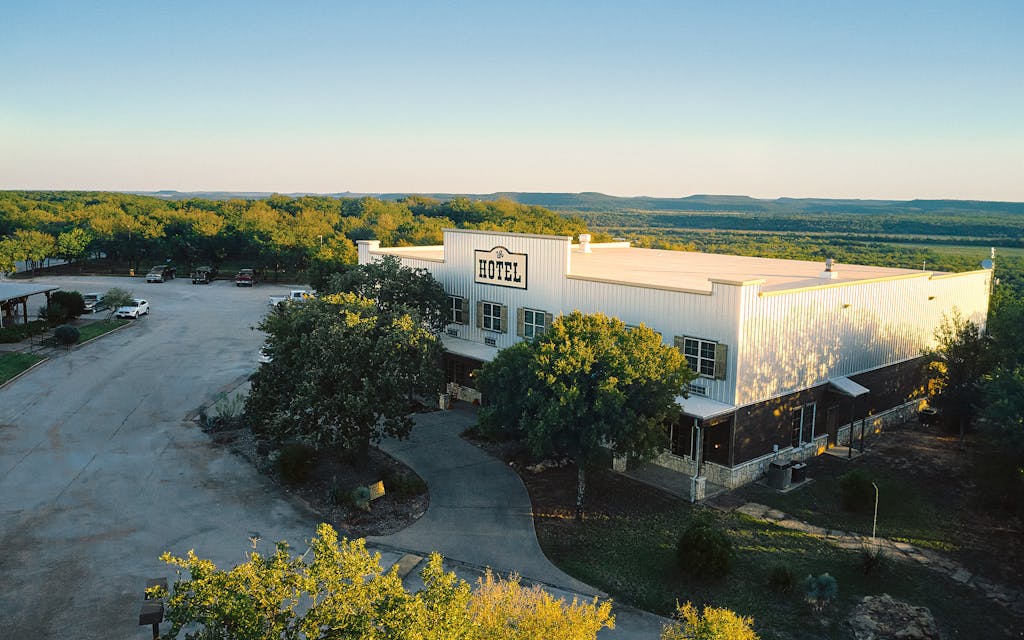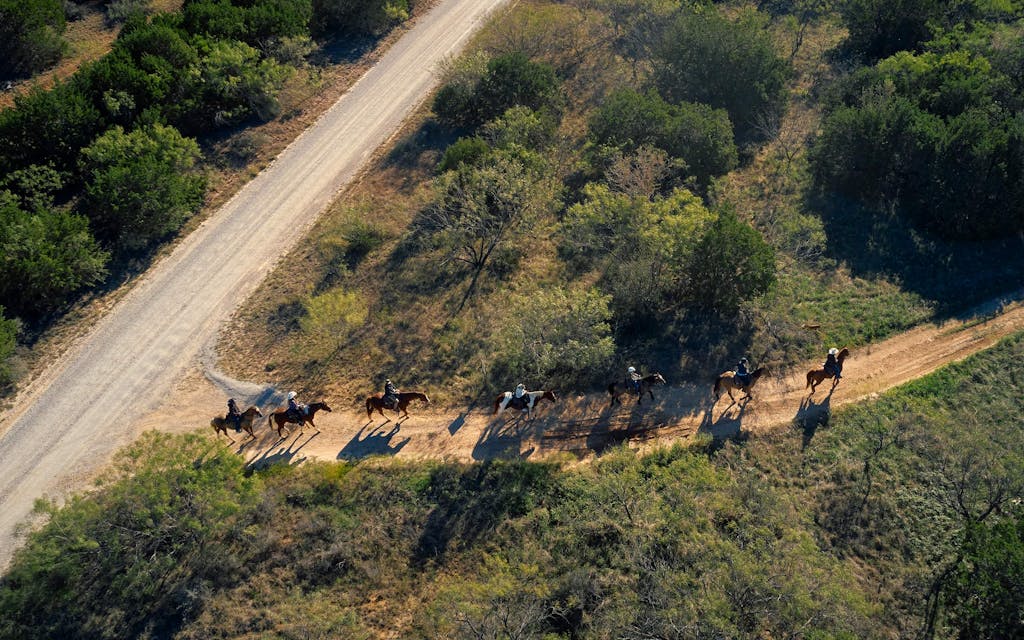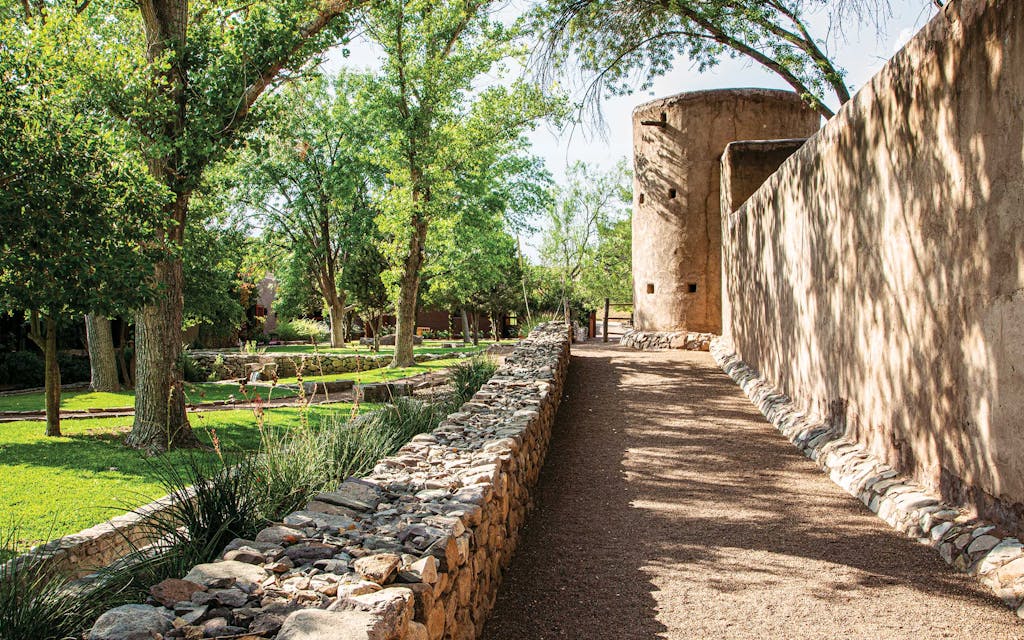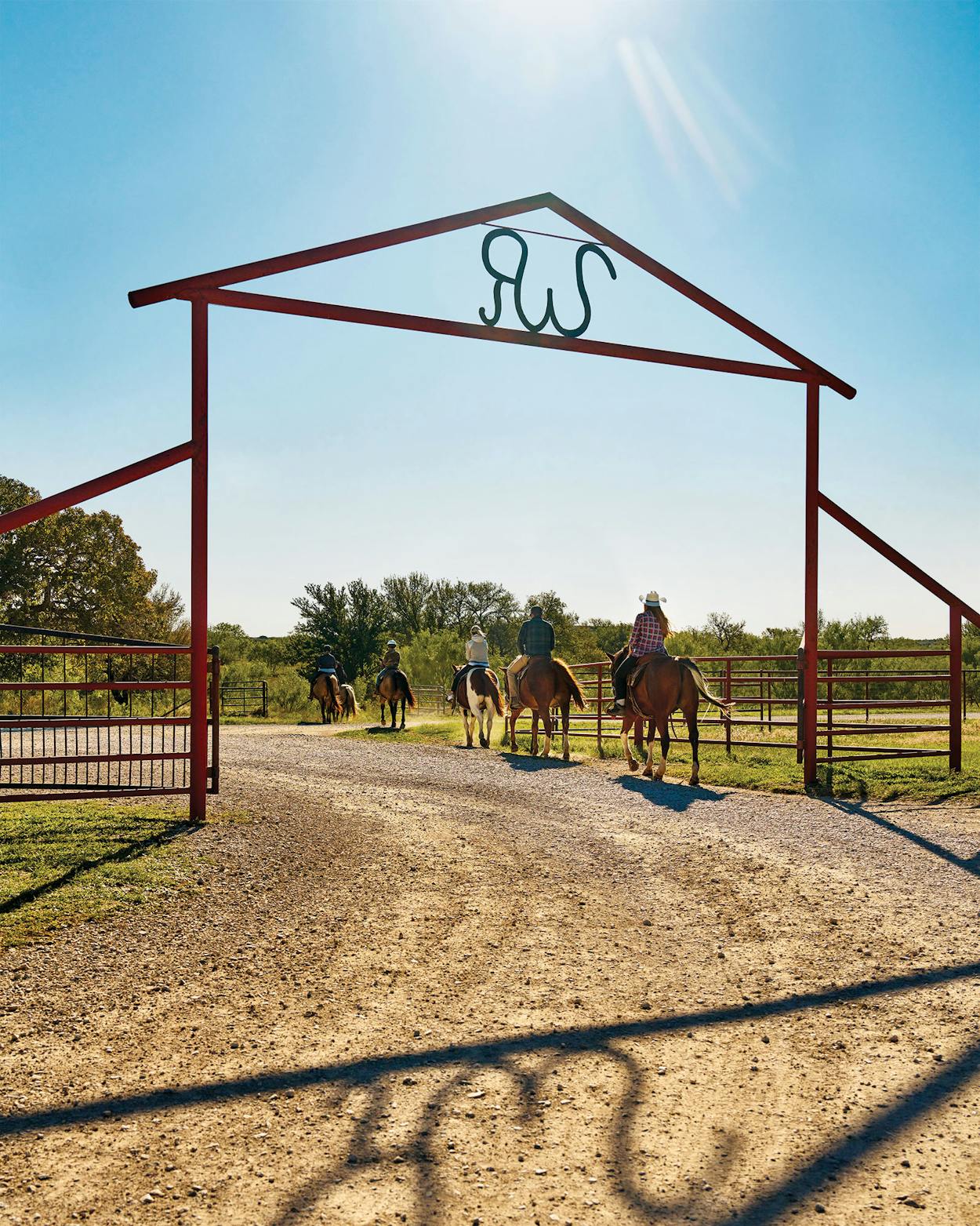The lariat sliced the air overhead as I circled my wrist counterclockwise, giving the wide loop momentum before I released it from my hand. A few feet away was a roping dummy, a small black calf made of spongy rubber that I’d mistaken for a decorative feature until I realized it was my target. Swinging the rope above me was instantly gratifying, a cinematic yeehaw gesture, but trying to land it around the head of a baby animal, even a fake one, felt as impossible as docking a spaceship. Twice my lariat thwacked the ground, grabbing only air, but on the third try, the rope slid over the calf’s pointy ears, and I whooped and pulled to tighten the hold.
“You’re a real cowboy now,” said a fellow ranch guest who’d been watching me. I am, in fact, a thoroughly urban creature more familiar with crowded parking lots than empty pasture. But like many visitors to Wildcatter Ranch, 1,500 acres of rolling countryside near Possum Kingdom Lake, about a two-hour drive from my Dallas home, I was curious how I might fare in a rugged landscape. What if I’d grown up chasing cattle on a ranch instead of bargains at NorthPark mall?
“Weekend cowboys” is how Wildcatter co-owner Anne Street Skipper describes folks like me. She and her brother Glenn Street opened the 41-room guest ranch in 2004 near Graham, a town her great-grandfather cofounded. A world map hanging in the wood-paneled dining hall has pushpins to mark visitors’ hometowns. Western Europe is nearly blanketed, while solid lines run up both U.S. coasts. The farther-flung locales form a kind of constellation: Tanzania, Iran, Kazakhstan. It turns out lots of people want the “Texas experience”—the chance to feed Longhorns, ride horses, stare into an unbroken sky—including Texans themselves. The Lone Star State is the only spot on the map as crowded as the United Kingdom.

I grew up a Texan, but for a long time I didn’t feel like one. My parents were Yankee transplants, and I was raised in Dallas, a cement city that paved over its rural past with neon skyscrapers and stadiums and celebrated those other Cowboys. Riding a horse, driving a pickup, shooting a gun: count me out. It was only after moving out of state that I began to wonder what I’d missed in rejecting such rural traditions, and years after returning to my hometown, I’m still trying to learn.
I chose Wildcatter because it fell in that middle range of ranches, between posh and primitive: none of the high-thread-count sheets or pickleball courts of trendy resorts but a pretty infinity pool and an old-school steakhouse with a nice, juicy filet mignon. Lodging options, which start at $189 a night, include rooms in the hotel, cabin suites, stand-alone cabins, and a four-bedroom ranch house that sleeps as many as sixteen. The activities, which cost extra, were appealingly rough-and-tumble. Archery, clay-pigeon shooting, horseback riding, roping, and tomahawk throwing: sign me up.
My cabin suite had vaulted ceilings with exposed beams and a sandstone fireplace, but the best part was the panoramic view from a back patio shared by three other suites (I had it to myself for a few blissful hours). The ranch’s website calls this region North Texas Hill Country, a bit of a marketing cheat. This swath of woodlands and prairie is technically the Western Cross Timbers, but the area does feel like the Hill Country, with sandstone bluffs and patches of green.


Soon after arriving, I sat in an old warhorse of a Jeep that rambled across open fields and wound along the dusty, weather-beaten roads of the property, and I could feel some tight inner coil unwinding. My driver was an affable 22-year-old named Abby Martin, one of four “wranglers” at the ranch who lead the various activities, and she navigated the rocky inclines with a casual proficiency. Her only complaint about living in the country was that there’s no Chick-fil-A.
She paused near a cliff with a dramatic view of the Brazos River, mud-brown as chocolate milk from clay and silt. We were not too far from where the writer John Graves once put in his canoe, paddling down the Brazos and capturing its quiet grandeur in his 1960 classic Goodbye to a River. Graves was mourning the urbanization of the Texas I eventually grew up in, but I liked to think we chased a similar peace. As he wrote, “Chances for being quiet nowadays are limited. Those for being unquiet seem to abound.”
The hush of the place was settling on me. I woke early the next morning and took a walk as the sun crept up, pale pink on the horizon. The only sounds were the cuh-caw of the crows, the mooing of Longhorns, the sing-song whistle of a bird, but what kind? I had to pull out my app: a Carolina wren. I’d become aware that I was painfully disconnected from the natural world, its rhythms and vocabulary lost to me, and I was trying to pay attention. I sipped coffee on the porch swing of the dining hall as a hummingbird went to town on a purple trumpet flower.
It hasn’t always been so peaceful out here. Fort Belknap, built in the area in 1851, guarded one of the more dangerous parts of the frontier. So violent was the clash between the white settlers and Native Americans that two nearby reservations had to be abandoned. From a spot on the property, you can see the trail taken in 1859 by Major Robert Neighbors as he marched tribes to safer territory in Oklahoma. (He returned only to be shot and killed.) The drama of Young County in the late nineteenth century inspired two John Wayne westerns, The Sons of Katie Elder and The Searchers, rendering a brutal era nobody wanted to relive into Hollywood heroics.

Larry McMurtry tried to puncture the Old West myth with Lonesome Dove, but the book was so epic he may have only furthered it. Gus and Call were based on ranchers Oliver Loving and Charles Goodnight, whose Goodnight-Loving Trail began at Fort Belknap.
My own trail ride came later that morning. I hoisted myself into the saddle of a gentle quarter horse named Ringo (after the outlaw Johnny Ringo, who took part in the “Hoodoo War” in Mason County in the 1870s). In spring, these fields are covered with wildflowers, but this was September, on the heels of a beastly hot summer. The tall, dry grass had become a mecca for grasshoppers, so many bounding from one stem to another that the ground appeared to be undulating. My guide was a former barrel racing champion named Laurelyn Bennett, age nineteen, who led our group of six down shady trails of juniper and mesquite. It was only my third time to ride a horse in my adulthood, but Ringo made it easy. The clip-clop of his hooves became a sonic meditation that quieted my mind to a soft hum.
Other activities proved more challenging. I showed little flair for tomahawk throwing or archery, but I did have a knack for clay shooting, where nobody was more surprised than me when I kept firing the 20-gauge pump action shotgun only to find a cloudburst of the shattered orange pigeon hanging in the air, shards clattering on the ground. Between my clay-shooting success and roping a (fake) calf three times, I guess I had some Texan scrapper in me after all.
That night, I sat on the rocking chair outside my cabin staring at the half-moon. McMurtry wrote about “sky longing,” a hunger that befell him after he moved from Texas, and as I stared into the stars growing brighter above the treetops, that was the phrase that came to mind. I will never be a cowboy, or anything close, but who could blame me for wanting to taste a bit of that wildness. To escape the city, yes, but also connect to the land.

Where to Rope, Ride, and Relax
Three other ranches for weekend cowboys.
Cibolo Creek Ranch, Marfa
This secluded 30,000-acre resort near the Chinati Mountains, in far West Texas, is fabled for its celebrity clientele and for offering high-desert luxury. The property’s three adobe forts, which house the guest rooms, date back to the 1850s, but Houstonian John Poindexter lavishly restored them in the 1990s. À la carte activities include shooting sports and ATV tours that climb into the mountains and show visitors Native American pictographs as well as breathtaking vistas. Rates start at $389 a night (suites average around $900 a night).
Dixie Dude Ranch, Bandera
Tradition is the lure of this down-home ranch in the Hill Country town of Bandera, known as the Cowboy Capital of the World. The all-inclusive prices cover two daily horse rides and family-style meals served at the clang of the chow bell. Dixie is still run by the same family that opened it in 1937. Rates start at $180 a day per person, $1,225–$1,325 per week, with reduced prices for children and groups.
Rough Creek Lodge & Resort, Glen Rose
With activities ranging from golf and fishing to paintball and a climbing wall, this 11,000-acre lakeside resort in Glen Rose, about an hour and a half southwest of Fort Worth, is a rustic playground, with hayrides and horseback riding as well. The restaurant, run by chef Gerard Thompson, is alone worth the visit. Rates, which include breakfast and dinner and some activities, start at $510 a night per adult (double occupancy); as many as three guests fifteen and younger can stay for free.
This article originally appeared in the December 2023 issue of Texas Monthly with the headline “How Texan Am I?” Subscribe today.







